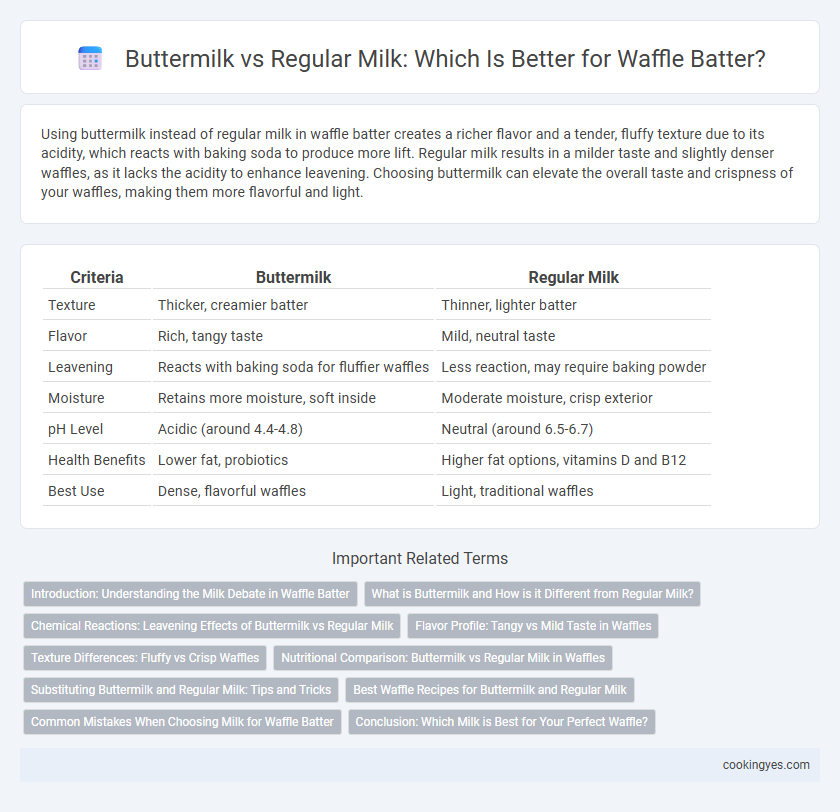Using buttermilk instead of regular milk in waffle batter creates a richer flavor and a tender, fluffy texture due to its acidity, which reacts with baking soda to produce more lift. Regular milk results in a milder taste and slightly denser waffles, as it lacks the acidity to enhance leavening. Choosing buttermilk can elevate the overall taste and crispness of your waffles, making them more flavorful and light.
Table of Comparison
| Criteria | Buttermilk | Regular Milk |
|---|---|---|
| Texture | Thicker, creamier batter | Thinner, lighter batter |
| Flavor | Rich, tangy taste | Mild, neutral taste |
| Leavening | Reacts with baking soda for fluffier waffles | Less reaction, may require baking powder |
| Moisture | Retains more moisture, soft inside | Moderate moisture, crisp exterior |
| pH Level | Acidic (around 4.4-4.8) | Neutral (around 6.5-6.7) |
| Health Benefits | Lower fat, probiotics | Higher fat options, vitamins D and B12 |
| Best Use | Dense, flavorful waffles | Light, traditional waffles |
Introduction: Understanding the Milk Debate in Waffle Batter
Choosing between buttermilk and regular milk significantly influences waffle batter texture and flavor. Buttermilk's acidity reacts with baking soda, creating tender, fluffy waffles with a subtle tang, while regular milk produces a milder, denser result. The milk type affects batter consistency and waffle crispness, making this decision crucial for achieving desired waffle quality.
What is Buttermilk and How is it Different from Regular Milk?
Buttermilk is a fermented dairy product with a tangy flavor and thicker consistency, created by culturing regular milk with lactic acid bacteria. Unlike regular milk, which is fresh and slightly sweet, buttermilk's acidity helps react with baking soda in waffle batter, producing lighter, fluffier waffles. Its lower pH and higher viscosity contribute to a tender texture and enhanced flavor compared to using regular milk in waffle recipes.
Chemical Reactions: Leavening Effects of Buttermilk vs Regular Milk
Buttermilk contains lactic acid which reacts with baking soda to produce carbon dioxide gas, resulting in lighter and fluffier waffles compared to regular milk. Regular milk lacks this acidity, so it relies solely on baking powder for leavening, which may yield a denser waffle texture. The acidic properties of buttermilk enhance browning and improve the overall rise, making it a preferred choice for waffle batter.
Flavor Profile: Tangy vs Mild Taste in Waffles
Buttermilk adds a distinct tangy flavor to waffle batter, enhancing the depth and complexity of the waffle's taste profile, while regular milk provides a milder, more neutral flavor. The acidity in buttermilk also reacts with baking soda, producing a lighter, fluffier texture alongside its signature tang. Choosing buttermilk over regular milk results in waffles with a richer, more pronounced flavor that balances sweetness and acidity.
Texture Differences: Fluffy vs Crisp Waffles
Buttermilk in waffle batter creates a tangy acidity that reacts with baking soda, producing a tender and fluffy texture by forming air pockets. Regular milk results in a smoother batter that yields waffles with a crisper exterior and slightly denser crumb. Choosing buttermilk enhances fluffiness and moisture retention, while regular milk emphasizes a crunchy bite and golden crust.
Nutritional Comparison: Buttermilk vs Regular Milk in Waffles
Buttermilk contains fewer calories and less fat than regular milk, making it a healthier choice for waffle batter while adding a tangy flavor that enhances taste. It also provides probiotics that support digestion, unlike regular milk which lacks these beneficial bacteria. Nutritionally, buttermilk offers higher levels of vitamin B12 and calcium, contributing to stronger bones and better energy metabolism in waffles.
Substituting Buttermilk and Regular Milk: Tips and Tricks
When substituting buttermilk with regular milk in waffle batter, add 1 tablespoon of lemon juice or white vinegar per cup of milk to mimic buttermilk's acidity for optimal texture and flavor. Using regular milk without acid can result in waffles that are less tender and slightly denser due to reduced chemical reaction with baking soda. For replacing regular milk with buttermilk, reduce or omit acidic ingredients, as the higher acidity in buttermilk reacts strongly with leavening agents, ensuring light and fluffy waffles.
Best Waffle Recipes for Buttermilk and Regular Milk
Buttermilk enhances waffle batter by providing a tangy flavor and tender texture due to its acidity, which reacts with baking powder or baking soda to create extra fluffiness. Regular milk offers a milder taste and works well in classic waffle recipes, yielding a crisp exterior and soft interior. The best waffle recipes using buttermilk include buttermilk cinnamon waffles and blueberry buttermilk waffles, while regular milk excels in versatile recipes like traditional Belgian waffles and vanilla waffles.
Common Mistakes When Choosing Milk for Waffle Batter
Using regular milk instead of buttermilk in waffle batter often leads to denser, less tender waffles due to the absence of acidity needed to activate baking soda. A common mistake is overlooking buttermilk's role in creating a light, fluffy texture through its chemical reaction with leavening agents. Selecting the wrong milk can also affect the waffle's flavor profile, making buttermilk the preferred choice for richer, tangier waffles.
Conclusion: Which Milk is Best for Your Perfect Waffle?
Buttermilk creates a tangier waffle batter that reacts with baking soda to produce lighter, fluffier waffles with a crisp exterior, ideal for a rich, flavorful breakfast. Regular milk offers a milder taste and smoother texture but results in denser waffles with less rise. For the perfect waffle, buttermilk is the best choice to achieve an airy, tender crumb and enhanced flavor complexity.
Buttermilk vs Regular Milk for waffle batter Infographic

 cookingyes.com
cookingyes.com